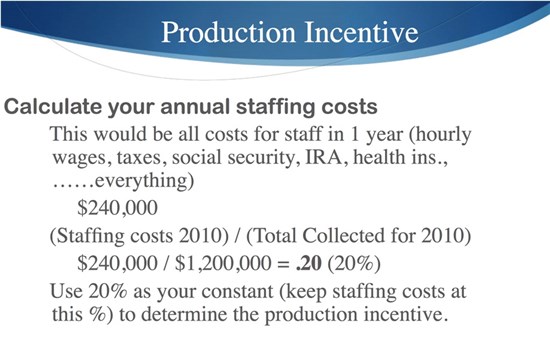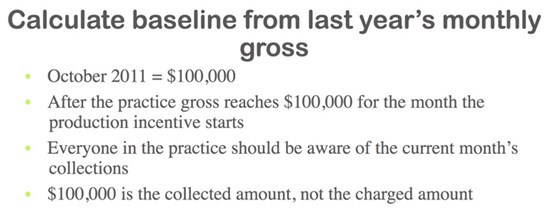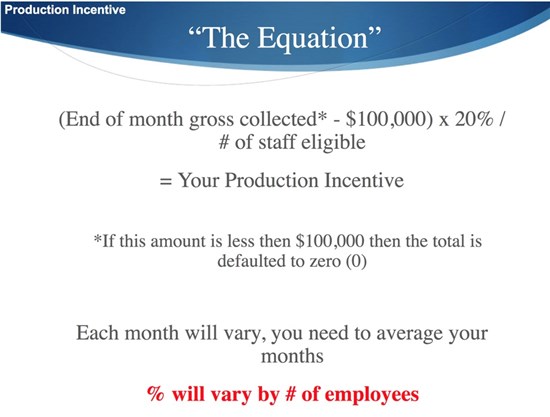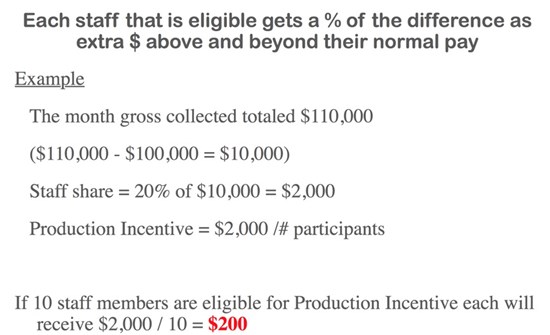By Chad Fleming, OD, FAAO
July 8, 2015

SYNOPSIS
Maximize productivity and morale with a production incentive model that rewards everyone in the practice when profits grow.
ACTION POINTS
USE PRODUCTION INCENTIVE MODEL. Reward staff as a group, rather than individually, for accomplishments like reaching practiceprofitability goals.
SET GOALS AT STAFF MEETINGS. Use staff meetings to set goals and mark achievements in reaching your goals.
CREATE FUN PLACE TO WORK. Build staff loyalty with staff dinners,community sport teams and other fun group activities to bond.
When our practice becomes more profitable, it is due not just to the doctors, or certain key players on our staff, but to all of our employees. For that reason, we use an employee motivation system called a “production incentive model”that rewards all employees when we’ve had a strong year financially. In a typical month, if we meet our goals, this may translate to an extra $200per employee–which is a powerful motivator to continue to deliver caring service.
Follow a Production Incentive Model
The production incentive model is a formula that rewards our team based on the production of the whole company. We wanted to create a team environment where everyone was rewarded for growth. In many models of bonuses, the opticians receive “spiffs” for selling certain product, yet they would not have this opportunity if the scheduler and front office team had not successfully gotten the patient into the office.
Four Key Steps to Implementing a Production Incentive Model
The following four charts show step-by-step how we use this employee incentive model to reward staff in our five-OD, 21-support staff practice. Keep in mind that the numbers in these charts are just an example to show you how the calculation process would work. You can then plug in the corresponding numbers for your own practice to implement this incentive model.




Set Goals at Staff Meetings & Recognize Outstanding Individuals
At staff meetings, we set goals–group goals–that differ from individual goals.The model plays out by using staff meetings to discuss previous incentives paid and future opportunities. We discuss how each position makes a difference in the performance of the office as a whole. The “bonuses” given are individual, and are subjective based on extraordinary performance. We have budget dollars that we will bonus each quarter that is subjective. Since our philosophy is based on more than dollars, we will use the budgeted amount for staff socials and promotional products.
We are the team eye doctors for the Wichita Force, an arena football team,so one of our socials, or out-of-the-office get-togethers, was renting out a corporate box at Intrust Bank Arena. We also get promotional products like infuser bottles, backpacks, car sun shades and North Face gear to give to staff based on performance. All of these product has the Wichita Optometry logo.
Gauge ROI From Incentive Plan
It is always difficult to measure the ROI of incentives and bonuses. We see the reward in how long individuals remain at our office and their job satisfaction. We work to keep our staff expenses at 24 percent of yearly production, which gives us a benchmark for determining how much money is going to be spent for reward/incentives and bonuses. The practice continues to grow and prosper with key staff members remaining on the team, so at this point, we believe the ROI has more than paid for itself.
Beyond Monetary Incentives: Create a Fun Place to Work
When an employee leaves a practice, it usually is notbecause of pay. They may say that, but if they have built a community with other staff members, whom they enjoy working with, then they are most likely to stay. Look at the popularity of social media and all the communities created online. People want to belong to something, and your optometry practice is no different. Create a culture, in our case, the Wichita Optometry culture.
In addition to the Wichita Force games described earlier, the staff also enjoy having dinners together and organizing meals to share together. These are family types of activities, and as one of two practice owners, it is important to us that we allow and financially support these events. Another activity that won the “fun factor” of our staff was a road trip that we took with three of our key staff to another office in another state to check out software that we were considering implementing. This turned into a fun activity that is still talked about in a very positive way.
Another surprisingly simple thing that has generated a culture of community is that we recently started paying $7 to have our name/logo embroidered on the scrubs that the staff wear. They love that they can wear their “team” out in public. The owners, again myself and Jeff Yarrow, OD, do not see this as that big of a deal, but our staff likes it, and communicates that they like feeling this way.
When you have a relationship with staff,it is much easier to let them know where they can improve than when there is no relationship and you need to make corrections. The “fun” allows for relationships to be built. There are boundaries for these relationships, as they must remain professional, but when your staff sees you outside of the office environment being yourself, that tends to translate into a stronger relationship and better staff performance.
Chad Fleming, OD, FAAO, is a partner with Wichita Optometry, P. A. in Wichita, Kan. To contact: optometryceo@gmail.com



























